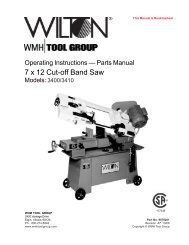This Rigger's Handbook is dedicated to Theodore C - Igor Chudov
This Rigger's Handbook is dedicated to Theodore C - Igor Chudov
This Rigger's Handbook is dedicated to Theodore C - Igor Chudov
You also want an ePaper? Increase the reach of your titles
YUMPU automatically turns print PDFs into web optimized ePapers that Google loves.
Chain Sling Assembly<br />
GRADE 80 CHAIN SLING ASSEMBLY<br />
BASIC TYPES OF CHAIN SLINGS<br />
Basic types of chain slings are dsignated throughout the<br />
industry by the following symbols:<br />
First Symbol (basic type):<br />
S - Single chain sling with master link and hook, or hook at each end.<br />
C - Choker chain sling with master link on each end; no hooks.<br />
D - Double chain sling with standard master link and hooks.<br />
T - Triple chain sling with standard master link and hooks<br />
Q - Quadruple chain sling with master link and hooks.<br />
Second Symbol (type of master link or end link):<br />
O - Oblong master link – Recommended standard for all types.<br />
P - Pear shaped master link – Available on request.<br />
Third Symbol (type of hook):<br />
S - Sling hook G - Grab hook<br />
F - Foundry hook L - Latchlok hook<br />
Sling tags are coded with numerals 1 through 4 <strong>to</strong> reflect number of branches<br />
in sling. Additional coding <strong>is</strong> defined as follows:<br />
AS - Adjustable sling SB - Single Basket<br />
ES - Endless single ED - Endless double<br />
SAL - Single adjustable loop DAL - Double adjustable loop<br />
AD - Adjustable double DB - Double basket<br />
HOW TO SELECT & ORDER THE PROPER CHAIN SLING<br />
1. Determine the weight and configuration of the load(s) <strong>to</strong> be<br />
lifted.<br />
2. Determine the type of chain sling required, according <strong>to</strong><br />
weight and configuration. (refer <strong>to</strong> the following pages)<br />
3. Determine the size of the body chain according <strong>to</strong> the<br />
working load limits. Be sure <strong>to</strong> take in<strong>to</strong> consideration the<br />
effect of the required angle.<br />
*Working load limit: The working load limit <strong>is</strong> the maximum<br />
load in pounds which should ever be applied <strong>to</strong> chain, even<br />
when chain <strong>is</strong> new, and when load <strong>is</strong> uniformly applied in<br />
direct tension <strong>to</strong> a straight length of chain.<br />
4. Determine the reach required <strong>to</strong> give the desired angle. The<br />
reach <strong>is</strong> measured from the upper bearing surface of the<br />
master link <strong>to</strong> the bearing surface of the lower attachment.<br />
If chain slings are <strong>to</strong> be used in pairs and are <strong>to</strong> be matched<br />
for reach, please indicate when ordering.<br />
5. Be sure <strong>to</strong> specify type, size and reach when ordering chain<br />
slings. For specifications on additional hooks, attachments<br />
and accessories, refer <strong>to</strong> the following pages.<br />
Note: Angle <strong>to</strong> the load on multiple leg slings will be 60° or<br />
greater as long as the d<strong>is</strong>tance between lifting eyes of load<br />
<strong>is</strong> NOT greater than reach shown on Identification Tag.<br />
HEADQUARTERS: 55 James E. Casey Drive • Buffalo, NY 14206 PHONE: 716.826.2636 FAX: 716.826.4412 www.hanessupply.com<br />
42<br />
YOUR SLING AND RIGGING SPECIALIST<br />
REACH AS REQUIRED<br />
ANGLE<br />
LOAD<br />
Type TOS<br />
MASTER<br />
OBLONG<br />
LINK<br />
SLING HOOK
















